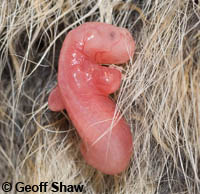We have visualised the short pregnancy of a small species of the kangaroo and wallaby family of marsupials, the tammar wallaby (Macropus eugenii), for the first time by high-resolution ultrasound. The study has shed light on a number of developmental events that are likely to be fundamental to all marsupials. These include a very rigid program of embryonic and fetal development with very little variation in pregnancy length, specialised movements of the endometrium that roll the embryo around the uterus before attachment, and climbing movements of the tiny fetus up to three days before birth. This latter finding is one of the earliest developmental behaviours observed in a mammal and prepares the immature young for the journey to its mothers pouch.
Marsupials represent approximately 6% of all mammal species and include those iconic pouched mammals of Australia such as the kangaroo, wombat and koala. Compared to eutherian mammals, which include more familiar animals such as the dog, cow and human, marsupials have ultra-short pregnancies and give birth to very immature, almost embryonic, young that complete the majority of their development attached to the teat, usually within a pouch. Kangaroos represent the largest extant marsupials and also give birth to the largest young. However, the newborn kangaroo still weighs less than one gram at birth and must climb blind and unaided from the birth canal to the pouch.
The tammar wallaby is one of the smaller species within the genus Macropus, which includes 14 species of kangaroos and wallabies, of which all but one species have embryonic diapause (the ability to halt development of the embryo). It is a model species for understanding marsupial reproduction and evolution and its biology, especially of its embryology and pre-natal development, is very well described. Tammar embryos in embryonic diapause can be reactivated during the breeding season (Jan-April) by removal of the sucking pouch young, which results in birth approximately 26 days later. While the hormonal and morphological changes surrounding this process have been intensively studied, it is not known how the marsupial embryo and fetus interacts with the mother in vivo. With this objective in mind, scientists from the Leibniz Institute of Zoo and Wildlife Research (IZW) in Berlin, Germany, the University of Melbourne, and the University of Sydney in Australia, examined the prenatal development of tammar wallabies using high-resolution ultrasonography.
The short intrauterine development of the tammar was monitored from reactivation of the 100-cell blastocyst in diapause to birth. After reactivation, the blastocyst could be visualized upon reaching a diameter of 1.5 mm. From at least halfway through pregnancy, there were strong rolling movements of the endometrium that massaged the expanding vesicle against the highly secretory endometrial surface. These unique movements possibly enhance exchange of uterine secretions and gases between the mother and embryo. This finding was unusual compared to eutherian pregnancies, in which uterine movements are usually suppressed so as not to disrupt implantation.
Once the reactivated embryos were detected by ultrasound their developmental progress was constant until birth. Thus, blastocysts in diapause that reactivated first were born first and the birthing order of females could be predicted from the size and stage of their embryos.
Surprisingly, the tiny tammar fetus displayed preparative climbing movements up to 3 days before birth that appeared as alternating grasping actions of the left and right forelimbs mimicking those required to climb to the pouch. The fetal forelimbs are well developed at this stage while the hindlimbs are still only buds. In eutherian mammals such highly coordinated movements occur developmentally much later.
The study has highlighted some fundamental adaptations of marsupials that are specific to their unique mode of reproduction. Future work will determine how widespread these adaptations may be within the Marsupialia.
SCIENTIFIC REPORTS, Nature publishing Group: link to full article here
Ultrasonography of wallaby prenatal development shows that the climb to the pouch begins in utero
Barbara Drews 1, Kathleen Roellig 1, Brandon R. Menzies 1, 2, Geoffrey Shaw 2, Ina Buentjen 1, Catherine A Herbert 3, Thomas B. Hildebrandt 1, Marilyn B. Renfree 2
1 Department of Reproduction Management, Leibniz Institute for Zoo and Wildlife Research, Berlin, Germany
2 Department of Zoology, University of Melbourne, Victoria 3010, Australia
3 Faculty of Veterinary Science, The University of Sydney, New South Wales 2006, Australia.
http://www.nature.com/srep/2013/130315/srep01458/full/srep01458.html
From text of press release by authors of the paper.




